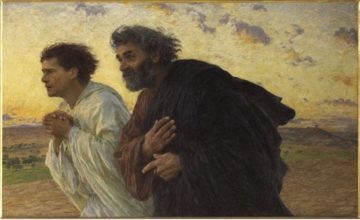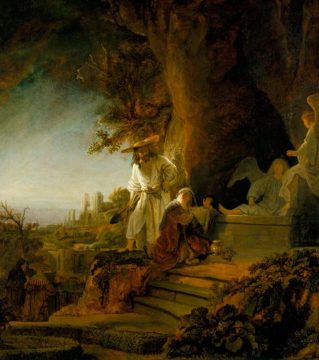As we anticipate and celebrate the Resurrection of Our Lord and Savior Jesus Christ, Franciscan Friar Fr. Paul Gallagher reflects on the Gospel from John. The content is edited by Franciscan Sister of Christian Charity Sister Anne Marie Lom and Joe Thiel. The excerpts from the Sunday readings are prepared by Joe Thiel. To read or download the complete pdf with excerpts for your prayer, please click here: Franciscan Gospel Reflection April 10 2022 Excerpts are from the Lectionary for Mass for Use in the Dioceses of the United States of America, second typical edition © 2001, 1998, 1997, 1986, 1970 Confraternity of Christian Doctrine, Inc., Washington, DC. Used with permission. All rights reserved. No portion of this text may be reproduced by any means without permission in writing from the copyright owner. Photo: Biblical Scene – Rembrandt Van Rijn – WikiGallery.org, the largest gallery in the world
John 20:1-9
Note: There are three possible Gospel readings for the celebration of Easter. Matthew 28:1-10 is usually read at the Easter Vigil Mass, John 20:1-9 is recommended for Masses in the morning, and Luke 24:13-35 has been used for afternoon celebrations. The vigil Mass is usually when the new members of the community are baptized and welcomed to the Lord’s Table for the first time. It is a beautiful and faith-filled celebration. However, the majority of people typically attend one of the Masses on Easter Sunday morning. Therefore, the focus here is on the text from John’s gospel.
On the first day of the week, Mary of Magdala came to the tomb early in the morning, while it was still dark, and saw the stone removed from the tomb. So she ran and went to Simon Peter and to the other disciple whom Jesus loved, and told them, “They have taken the Lord from the tomb, and we don’t know where they put him.” So Peter and the other disciple went out and came to the tomb. They both ran, but the other disciple ran faster than Peter and arrived at the tomb first; he bent down and saw the burial cloths there, but did not go in. When Simon Peter arrived after him, he went into the tomb and saw the burial cloths there, and the cloth that had covered his head, not with the burial cloths but rolled up in a separate place. Then the other disciple also went in, the one who had arrived at the tomb first, and he saw and believed. For they did not yet understand the scripture that he had to rise from the dead.
Background:
This familiar gospel may not seem an unusual choice for Easter, even though the Risen Lord is not encountered. Rather, the text centers on the empty tomb, and the first disciples’ encounter with the absence of the body of Jesus. Belief in the resurrection for John’s community was not based on their firsthand experience of the risen Christ, but on the testimony and faith of the Christian community. Our faith journey also has its beginnings on the faith and testimony of those who have come before us.
John begins this text while it is dark. Mary of Magdala, Peter, and the disciples are in the dark about what has really taken place. When Mary discovers the empty tomb, she presumes that someone has taken the body. The possibility that Jesus has risen is not even a consideration. But by including that Mary had first believed that the body was stolen, John confronts those who suggested that the Christians’ belief in resurrection could more easily be explained if it were a fact that someone removed the body.
Throughout his gospel, John commonly uses a lack of understanding by those who encounter Jesus as a tool for Jesus to further explain his role. Because of their lack of understanding, these people present an opportunity to receive further clarification and be brought to a deeper faith. Think of the account of the woman at the well, the man born blind, and even Martha and Mary. Mary’s lack of comprehension at the tomb is not a problem because she has faith in Jesus; the understanding will continue to develop within her as it does within the early disciples.
 The text that will be used throughout the Easter season will highlight this development. Next Sunday the text will describe the disciples’ first encounter with the risen Lord in the upper room.
The text that will be used throughout the Easter season will highlight this development. Next Sunday the text will describe the disciples’ first encounter with the risen Lord in the upper room.
Reflection Questions:
- This gospel focuses on the empty tomb, not the encounter with the risen Lord. What is your response to celebrating Easter without a gospel of the risen Jesus? How might this be an invitation to ponder some aspect of your faith and relationship with God?
- At the beginning of this gospel, John says that it was still dark. How many ways might that statement be understood at this point about the early disciples? How might this also be a true statement about you?
- John does not tell us why Mary went to the tomb. What are some of the reasons that arise in you why she might have gone to the tomb?
- Why do you think John tells his community that Mary of Magdala went to the tomb first? (He could have easily not included that piece of information in the text.) What does it say to you?
- John states that when the other disciple entered the empty tomb, he saw and believed, but John does not say that Peter believed when he entered the tomb. How does the experience of both Peter and the other disciple speak to you?
- How will your experience of Easter be different this year? In what ways will it be like the experience of the dark cold empty tomb? What will be your experience of Mary, who ventures out in the dark of night, or of Peter, or of the beloved disciple?
- Can you take some time now to talk with God honestly and openly about your situation, your feelings as you approach this Easter, and what you need God to teach/show you about the life that God desires to reveal to you?



